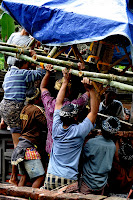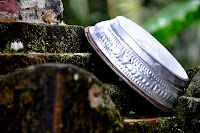 Oka is waiting at the car to take us to another temple, the temple of holy water. This water you can drink, Annie tells me, or swim. But it is very cold. More highway close calls, and we descend to another temple. We navigate stairs and turns, past koi ponds and gardens and vendors. (Annie points out how they attach themselves to the other tourists, but not to me because I wear traditional Indonesian dress).
Oka is waiting at the car to take us to another temple, the temple of holy water. This water you can drink, Annie tells me, or swim. But it is very cold. More highway close calls, and we descend to another temple. We navigate stairs and turns, past koi ponds and gardens and vendors. (Annie points out how they attach themselves to the other tourists, but not to me because I wear traditional Indonesian dress).  We stop at the long square pools of blue-hued water (In Indonesian, water is called “air”: pronounced “ire” and don’t forget to roll that “r” like it’s Spanish--my favorite part).
We stop at the long square pools of blue-hued water (In Indonesian, water is called “air”: pronounced “ire” and don’t forget to roll that “r” like it’s Spanish--my favorite part).Above mossy black-green headstones, carved spouts shoot icy water onto the men and women, young and very old, submerging themselves, and their prayers, in its cleansing stream. It’s beautiful to watch. They place their smoldering incense and palm and flower offerings on a headstone, the price for entry, then slowly wade through the icy blue. They clasp hands under the stream, heads bowed. I try to imagine what they pray for, what cold holy water feels like, what they see when they submerge themselves.
 Some hold their breath and wait, others pop up quickly with surprise. All are dripping. Dry clothes that had once billowed on entry, now trace all each body’s most intimate shapes and
Some hold their breath and wait, others pop up quickly with surprise. All are dripping. Dry clothes that had once billowed on entry, now trace all each body’s most intimate shapes and  curves. He holds his head under the spout, in prayer, letting the water stream down his head (the most holy) for minutes at a time. A old woman in an eggplant-colored kaballah, fill a white bottle with water to be used later or left on some shrine someplace else. My curious eye or camera shutter never distract their fervent devotion.
curves. He holds his head under the spout, in prayer, letting the water stream down his head (the most holy) for minutes at a time. A old woman in an eggplant-colored kaballah, fill a white bottle with water to be used later or left on some shrine someplace else. My curious eye or camera shutter never distract their fervent devotion. The sound of the camera shutter, or a strange woman peering over the brick wall, does distract the men next door. A few feet over is group of 50 or more men standing in a smaller, higher—thus more holy--fenced off pool. There is shouting and
 yelling, scratching of heads, and speculating. Talking over the rusted iron fence, one of them invites me to watch as they hoist a massive, tarp covered stone pagoda onto a giant bamboo gurney (the bamboo poles appear almost a six inches in diameter -- are large beyond belief, but still seem like they'll snap under the weight), then lift it, over their heads, to a high pedestal in the pool. One man shouts orders from the pedestal, the masses grunt, heave, argue and eventually laugh.
yelling, scratching of heads, and speculating. Talking over the rusted iron fence, one of them invites me to watch as they hoist a massive, tarp covered stone pagoda onto a giant bamboo gurney (the bamboo poles appear almost a six inches in diameter -- are large beyond belief, but still seem like they'll snap under the weight), then lift it, over their heads, to a high pedestal in the pool. One man shouts orders from the pedestal, the masses grunt, heave, argue and eventually laugh. 
I revel with how many men it's going to take to lift this one small stone. I think of Annie’s one holy man with big powers, carving out the stone temples and hoisting rocks 100 times the size of this. It’s much more magical to envision one man doing amazing things, alone. But it’s much more interesting watching this large group of men—all focused on the same goal, all practicing the same religion, all wearing similar style clothing. Yet all so different, the angle of a jawbone, the jutting of a lip, the lines of a face, the silhouette of a nose as the sun hits it. It’s the perfect time for watching, and for photos, since they’re too busy struggling to hide or pose.
 As I snap my camera, Annie laughs that it’s always something with me. Always something happening. I see nothing else like it. You show up in Bali you go to big ceremony, you find kaballah, you go to wedding, you show up at stone temple, it is yours alone. You come here, there is this. Always something. We stand in the Indonesian sun. I am laughing. I shrug my shoulders. I don’t know, Annie, guess I just got to Bali at just the right time. (There is no Indonesian translation for what’s been happening lately.)
As I snap my camera, Annie laughs that it’s always something with me. Always something happening. I see nothing else like it. You show up in Bali you go to big ceremony, you find kaballah, you go to wedding, you show up at stone temple, it is yours alone. You come here, there is this. Always something. We stand in the Indonesian sun. I am laughing. I shrug my shoulders. I don’t know, Annie, guess I just got to Bali at just the right time. (There is no Indonesian translation for what’s been happening lately.) Even when there is nothing – with you it is something…always see something else.she pauses...I think it is good.
 I think I know what she means and I think it's good too. I’ve kneeled to grab a shot of the sun hitting an empty, upturned, silver offering pan. I have to squint to look up at her. Hmmm, I don’t know. But I like it. I am glad you like it.
I think I know what she means and I think it's good too. I’ve kneeled to grab a shot of the sun hitting an empty, upturned, silver offering pan. I have to squint to look up at her. Hmmm, I don’t know. But I like it. I am glad you like it. Then, in the corner of my eye, I see her look around and then down to actually see me. What you taking picture of? She laughs, exasperated.
The sun, Annie! It’s the sun—what is the Indonesian word for sun?
Matahari.
Eye of the day. I repeat it over and over. Annie teaches me bulon (moon) and bintang (star…which is also the name of the Indonesian equivalent to Rainier Beer back home.)
 As I snap more shots of the men and make up my mind to leave after this one last try (we’ve been here for hours), I mouth matahari over and over--trying to familiarize my tongue to its form, as I stand in its light.
As I snap more shots of the men and make up my mind to leave after this one last try (we’ve been here for hours), I mouth matahari over and over--trying to familiarize my tongue to its form, as I stand in its light.
The stone pagoda is lowered, and pushed back up. Lowered and pushed back up. As matahari shines, the human machine continues to exhale and lifting.
Then they try again. Thin muscles strain even more, men leap from side to side, splashing in holy water, pushing and holding. The bamboo poles never break, only bend, under the enormous weight. Then finally, in a slow and back-breaking push, they make it to the top. One massive stone rests on the other, where it will stay for its single lifetime, and hundreds, perhaps thousands of ours. All the while, in the midst of the chaos, the steady stream of quiet worshipers continue to wade through the pools, past floating bits of magenta and orange flowers, and offer prayers to their gods.




Oh my gosh Joya, I love these pictures!!
ReplyDeleteDude! Thank you! Thank you! Thank you!
ReplyDelete